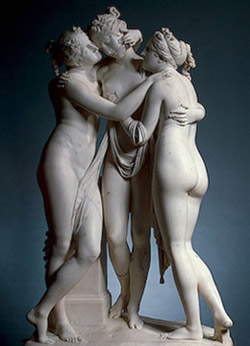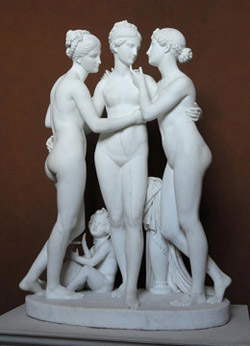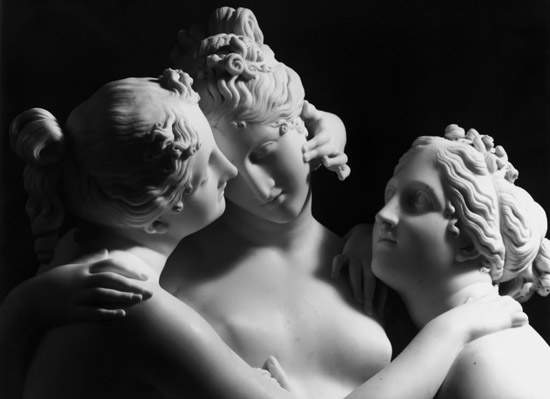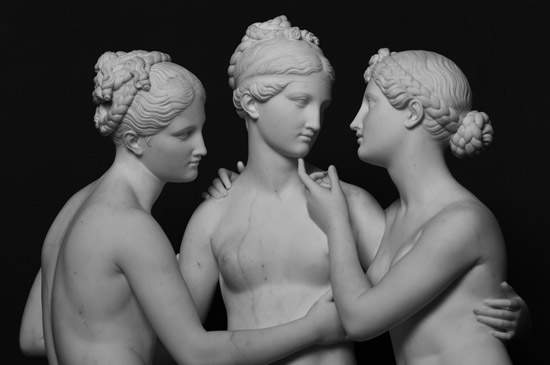Sensuality and purity: the Three Graces of Canova and Thorvaldsen compared
When Antonio Canova created, at the invitation of Josephine de Beauharnais, his celebrated Three Graces, he actually succeeded in setting off a challenge, and the theme of the Graces represented an important test for many artists of the time: the first to take up the challenge was the Dane Bertel Thorvaldsen. Then came the works of James Pradier, John Gibson, and Carlo Finelli, who, however, opted for the Dancing Hours variant. But the most interesting comparison is precisely with Thorvaldsen, who has always been considered Canova’s main rival.
It was not long before the Dane set to work: he began his group in 1817, and Canova had finished his just a year earlier. The work saw the light of day in 1819 and is now in the Thorvaldsens Museum in Copenhagen, while Canova’s is in theHermitage in St. Petersburg.
 |
| Antonio Canova, The Three Graces, 1812-1816, St. Petersburg, Hermitage |
 |
| Bertel Thorvaldsen, The Three Graces, 1817-1819, Copenhagen, Thorvaldsens Museum |
If until then Thorvaldsen was regarded as the sculptor who most closely adhered to the neoclassical aesthetic, his Three Graces only confirmed the character of his art. Which was, essentially, an art that sought not only to subdue any motion of the soul, but also tried to avoid movements that might suggest to the viewer a certain emotional involvement. In Canova, however, the opposite occurs. Even in their exceptional formal beauty that met the canons of ideal beauty sought by neoclassical artists, the Canova Graces embrace each other with a certain transport, look into each other’s eyes, caress each other gently, the one in the center even dropping her head in the direction of her companion to her right. What’s more, their bodies appear natural. This is because Canova believed that the ideal beauty had its basis in nature: that is, there can be no ideal beauty that does not start from nature. It is no coincidence that, after seeing the works of Phidias, he had written to Quatremère de Quincy that the Greek sculptor’s statues are true flesh, that is, beautiful nature.
Thorvaldsen probably feels the comparison. One would not otherwise explain the decision not to reproduce the ancient scheme that the central figure had to be represented from behind-an innovation introduced by Canova himself. And, like Canova, he grants to his Three Graces that exchange of glances and gestures that so profoundly characterized his rival’s figures, albeit without reaching their intensity. Indeed, the gazes of Thorvaldsen’s Graces are fixed, their faces impassive. We do not see in any of them the sigh that seems to escape from the mouth of the central figure in the Canova group. We do not see the almost dreamy gaze of the one on the left, and we do not see the participation of the one on the right.
 |
| Antonio Canova, The Three Graces, detail |
Instead we find an additional detail: the Cupid playing the zither at the feet of the three young women, probably inserted to better balance the composition, since the space between the legs of the Graces, in the absence of Cupid, would have been too empty. And here again we notice the great distance between Canova and Thorvaldsen. In Canova, the legs of the Graces brush against each other, and this device suggests to us that underlying sensuality often present in his works. In Thorvaldsen, the distance is such that a Cupid on the left and a column on the right had to be inserted to fill the gap. And who knows if Thorvaldsen’s Graces have such a fixed gaze as they are intent on listening to the melody of the zither.
 |
| Bertel Thorvaldsen, The Three Graces, detail |
But let us then look at the bodies. Canova’s Graces are well-formed and comely young women. Thorvaldsen’s are little more than children. The impression we get is that Canova’s Graces appear to us as three women depicted in a sensual, languid, and refined embrace, while Thorvaldsen’s seem to us, on the contrary, to be three teenagers engaged in innocent play. Even the gesture of the right-hand figure in Thorvaldsen, who touches her companion’s chin with her finger, strikes us as devoid of any erotic intent.
Sensuality in Canova, purity and candor in Thorvaldsen: these are probably the feelings that the respective Graces arouse in the viewer. It is no coincidence that sources report that King Ludwig of Bavaria, after seeing both works, had this to say that Canova’s Graces inspire lasciviousness, while Thorvaldsen’s inspire chastity. The king, in short, regarded Thorvaldsen’s Graces as characterized by a certain divine essence. Granting preference, as it is fair and easy to assume, to the Danish artist. A judgment, then, contrary to what we contemporaries might make. Tastes, over time, change, but great masterpieces remain. And they allow us to appreciate the great differences between two seemingly similar sculptors, but endowed with two deeply contrasting spirits. Impossible to determine objectively which work is the better of the two: the Three Graces by Canova and Thorvaldsen best embody two different conceptions of neoclassicism. The judgment is up to the personal inclination of the observer.
Warning: the translation into English of the original Italian article was created using automatic tools. We undertake to review all articles, but we do not guarantee the total absence of inaccuracies in the translation due to the program. You can find the original by clicking on the ITA button. If you find any mistake,please contact us.




























